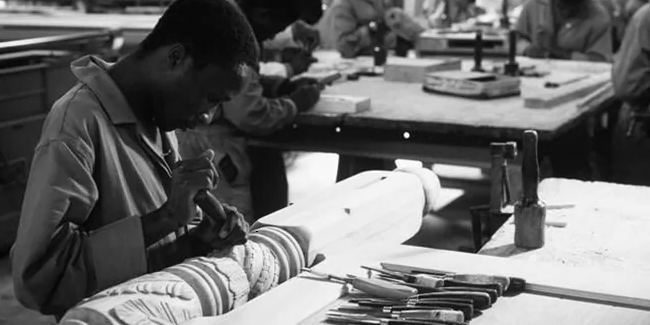Quality control is a critical process in any manufacturing industry, and billiard table production is no exception. An exceptional billiard table isn’t just about aesthetics; it’s a perfect blend of design, materials, craftsmanship, and precision. This makes quality control essential to ensure that each table meets the highest standards of performance and durability. At Presidential Billiards, we take pride in our stringent quality control processes, which we’ll explore in this article.
Quality Control Starts With Materials
The first step in quality control lies in the selection of materials. Only the best woods, slates, and cloths are chosen for the construction of our billiard tables.
- Wood: We source high-quality hardwoods such as oak, maple, and mahogany. Each piece of wood is carefully inspected for flaws, ensuring strength and aesthetic appeal.
- Slate: Our slate is sourced from the best quarries, and each piece is rigorously checked for flatness and imperfections. This ensures a smooth and consistent roll for the billiard balls.
- Cloth: The cloth used to cover the slate surface is inspected for uniform thickness and weave. This ensures a smooth, fast surface that withstands wear and tear.

Precision in Manufacturing
Quality control continues throughout the manufacturing process. Every step, from cutting and joining the wood to leveling the slate and stretching the cloth, is meticulously monitored.
- Cutting and Joining: The wood for the table frame, legs, and rails is precisely cut and joined using techniques like mortise and tenon joinery, known for their strength. Each joint is inspected to ensure it’s secure and seamlessly finished.
- Slate Leveling: The slate is carefully leveled and inspected to guarantee a flat playing surface. Even the slightest imperfection can affect the roll of the balls, so this step is crucial in our quality control process.
- Cloth Stretching: The cloth is stretched over the slate using a method that ensures it’s tight and wrinkle-free. This process is carefully monitored to avoid any loose areas or puckering.

Final Inspection
The final step in our quality control process is a thorough inspection of the completed table. This includes checking the table for level, ensuring the cushions and pockets are securely and correctly aligned, and inspecting the finish of the table for any flaws. Any necessary adjustments are made at this stage, and each table is polished to perfection before it leaves our workshop.
Conclusion
Quality control in billiard table manufacturing is a meticulous process that ensures each table meets the highest standards of performance, durability, and aesthetic appeal. It’s a testament to the dedication and precision of our team at Presidential Billiards. When you choose a Presidential Billiards table, you’re not just choosing a game table; you’re choosing a commitment to quality. Explore our range today and experience the difference that quality craftsmanship makes.
FAQ’s
What are the key components of Presidential Billiards' quality control process in billiard table manufacturing?
The key components of Presidential Billiards’ quality control process in billiard table manufacturing revolve around ensuring the highest standards at every production stage:
- Material Selection: We start with selecting premium materials, including high-grade hardwoods for frames and legs, meticulously sourced slate for the playing surface, and durable, high-quality cloth.
- Precision Manufacturing: Each step in the manufacturing process, from cutting and joining wood to leveling the slate and stretching the cloth, is performed with precision, using advanced tools and techniques.
- Thorough Inspection: After assembly, every table undergoes a detailed inspection. We check for level accuracy, the correct alignment of cushions and pockets, and the flawless finish of wood and cloth.
These steps ensure that each billiard table not only meets but exceeds industry standards, delivering on both functionality and aesthetics.
How does the selection of materials like wood, slate, and cloth impact the quality and performance of a billiard table?
The selection of materials like wood, slate, and cloth is crucial in determining the quality and performance of a billiard table. High-grade woods such as oak or mahogany ensure durability and aesthetic appeal, while the use of finely milled slate provides a level and consistent playing surface essential for accurate gameplay. The cloth, often a wool-nylon blend, affects the speed and smoothness of ball movement, contributing to both the playability and the visual allure of the table.
What measures are taken to ensure the precision and perfection of each billiard table during the manufacturing process?
During the manufacturing process of billiard tables, several measures are taken to ensure precision and perfection:
High-Precision Machinery: Advanced machinery, often computer-controlled, is used for cutting and shaping the wood and slate, ensuring accuracy to the millimeter.
Expert Craftsmanship: Skilled artisans meticulously assemble and finish each table, employing techniques like hand-finished detailing and precise joinery for seamless construction.
Quality Control Checks: Throughout the process, rigorous quality control checks are conducted. This includes ensuring the flatness of the slate, the evenness of the cloth application, and the stability and levelness of the table.
These steps ensure that each billiard table not only meets but surpasses industry standards, combining flawless function with exquisite form.
.

